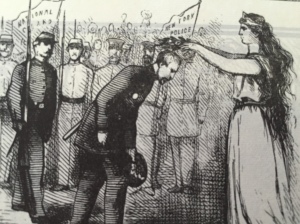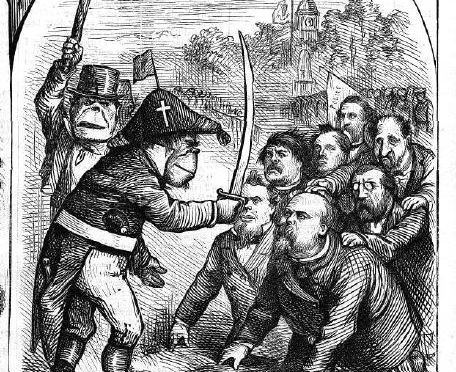I use “Google Alerts” to keep abreast of Internet conversations, events and posts about Thomas Nast. This week I came across this masters thesis written by Laura Woolthuis, Utrecht University, Netherland
Getting Nasty: Thomas Nast and the simianization of the Irish in late nineteenth-century America.
dspace.library.uu.nl:8080/handle/1874/323536
I was honored to be included in the citations. Woolthuis’ thesis is well-written, well-researched and provides a thorough history of the Irish-simian stereotype. Woolthuis provides excellent resources on Irish physiognomy and background on Irish “whiteness” studies.
But the blanket assessment that Nast always drew the Irish as beasts or thugs, or that he felt a singular hatred in his heart for Irish or Catholics has foundational problems. Nast was a man of images, not of letters – correspondence that might shed valuable light on inner feelings do not exist on the subject. His personal thoughts toward the Irish are simply not known.
Nast’s perceived attitude toward Irish and Catholics comes solely from his images published in Harper’s Weekly. These images reflect political controversies and positions and are editorial reactions to specific events in the public arena. In fact, at the height of Nast’s popularity (peaking with his anti-Tweed, anti-Catholic content), at a time when being Catholic was not popular, Harper’s nevertheless places Nast’s personal Catholic roots front and center in a biographical feature of their “special artist.”
Decades later, his contemporary biographer, Alfred Bigelow Paine, quite possibly sensing Nast’s vulnerable legacy as a Catholic-hater, goes to great length to correct the perception that Nast held an instinctive, deep-seated hatred toward Catholics or Catholicism.
Simply put, Nast called out hypocritical behavior, violence, and corruption wherever he saw it, and he saw it within groups of people who had loud voices who steadily voiced an ambition for political power and recognition. A growing demographic in New York City, Irish Catholics were often players in these controversies. In mid-nineteenth century New York City, real-life examples of political activism flourished. Participants, regardless of race, ethnicity, or religion came to public attention through the harsh caricatures of cartoonists, of which Nast was the most famous during this era.
Coming from a German-Catholic background, his issue was not the religion nor its participants, but rather, the American leadership of the Roman Catholic Church’s and its foray into local politics and public funding, the Irish-Catholic alliance with Tweed, and the rank and file Hibernian alignment with the Democratic Party’s anti-abolitionist platform. Nast drew favorable images of Catholic clerics, most notably Father Dollinger, who held progressive Catholic views. Later, the Irish’s visible and organized attacks toward the Chinese in America renewed and reinvigorated further scrutiny by Nast on Irish behavior.

In 1869, Nast included the Irish at Uncle Sam’s Thanksgiving Dinner, the one Irishman’s facial features shown as slightly simian, so viewers and readers could not mistake his message that the Irish, as well as other ethnic stereotypes included in the drawing, deserved a seat at the uniquely American celebration. The Irish wife is devoid of stereotype and is most pleasantly drawn.

Later, in “Something That Will Not Blow Over,” Irish policeman (their admirable service reported by Harper’s) receive laurels from Columbia for their valor in serving the public during the religious, tension-filled Orangeman riots. These Irish public servants look like any other American with a western-European ancestry.
As he evolved from illustrator to political caricaturist, Nast zeroed in on trouble and troublemakers. This embodied his raison d’être. In addition to what he perceived as controversial behavior surrounding Tweed, Nast implicated the Irish (and to a lesser extent his fellow Germans – see The Chinese Question) for their oppression and cruelty toward the Chinese. It is an inconvenient and unpleasant truth, that a notable portion of the Irish-Americans in New York at the time, held and defended white supremacist beliefs that today would be viewed as morally reprehensible. Had Tweed not strategically stroked the strings of the Irish harp, and had the Irish not danced to Tweed’s tune, it is doubtful that Nast would have found motivation to draw the images of the Irish for which he is vilified today.
It is easy to pick out a Nast negative. What would a positive Irish-Catholic look like in a Nast drawing? They are there. They blend into the background. In the nature of the Nast beast, it is much harder to prove a positive.

